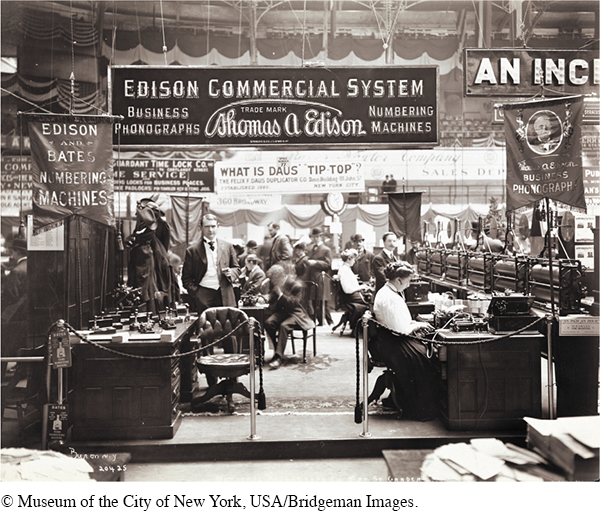The American Promise: Printed Page 538
The American Promise, Value Edition: Printed Page 496
The American Promise: A Concise History: Printed Page 562
White-Collar Workers: Managers, “Typewriters,” and Salesclerks
In the late nineteenth century, a managerial revolution created a new class of white-
The American Promise: Printed Page 538
The American Promise, Value Edition: Printed Page 496
The American Promise: A Concise History: Printed Page 562
Page 539Until late in the century, when engineering schools began to supply recruits, many skilled workers moved from the shop floor to positions of considerable responsibility. Captain William “Billy” Jones, son of a Welsh immigrant, grew up in the heat of the blast furnaces, where he worked as an apprentice at the age of ten. Jones, by all accounts the best steelman in the business, took as his motto “Good wages and good workmen.” In 1872 Andrew Carnegie hired Jones as general superintendent of his new Pittsburgh steelworks. Although Carnegie constantly tried to force down workers’ pay, Jones resisted, and he succeeded in shortening the shift from twelve to eight hours by convincing Carnegie that shorter hours reduced absenteeism and accidents. Jones demanded and received “a hell of a big salary”—$25,000, the same as the president of the United States.
The new white-
The American Promise: Printed Page 538
The American Promise, Value Edition: Printed Page 496
The American Promise: A Concise History: Printed Page 562
Page 540Sylvie Thygeson was typical of the young women who went to work as secretaries. Thygeson grew up in an Illinois prairie town and went to work as a country schoolteacher after graduating high school in 1884. Realizing that teaching school did not pay a living wage, she mastered typing and stenography and found work as a secretary to help support her family. According to her account, she made “a fabulous sum of money” (possibly $25 a month). Nevertheless, she gave up her job after a few years when she met and married her husband.
But by the 1890s, secretarial work was the overwhelming choice of native-
As a new consumer culture came to dominate American urban life in the late nineteenth century, department stores offered another employment opportunity for women in the cities. Boasting ornate facades, large plate-

The American Promise: Printed Page 538
The American Promise, Value Edition: Printed Page 496
The American Promise: A Concise History: Printed Page 562
Page 541REVIEW How did business expansion and consolidation change workers’ occupations in the late nineteenth century?